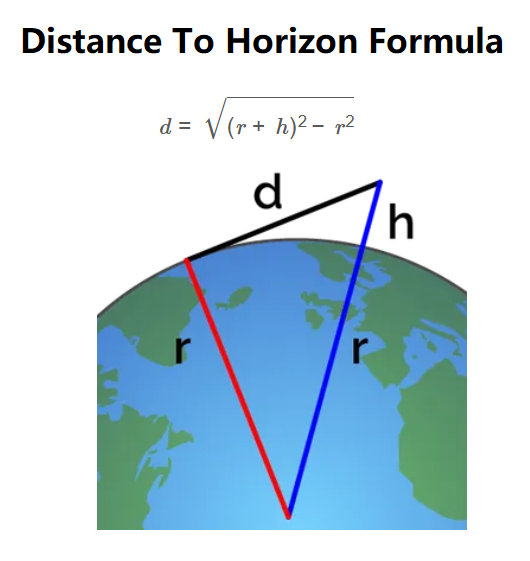1. What is Distance to Horizon Calculator?
Definition: This calculator computes the distance to the horizon (\( d \)) from an observer's height above the surface of a celestial body, assuming a spherical shape.
Purpose: It is used in navigation, astronomy, and geography to determine how far an observer can see to the horizon on a planet or moon.
2. How Does the Calculator Work?
The calculator uses the formula for distance to the horizon:
Formula:
\[
d = \sqrt{(r + h)^2 - r^2}
\]
Where:
- \( d \): Distance to the horizon (m, km, mi)
- \( r \): Radius of the celestial body (m, km, mi)
- \( h \): Height of the observer above the surface (m, km, mi)
Unit Conversions:
- Radius (\( r \)) and Height (\( h \)): m, km (1 km = 1000 m), mi (1 mi = 1609.344 m)
- Distance (\( d \)): m, km (1 km = 1000 m), mi (1 mi = 1609.344 m)
Steps:
- Select a celestial body or enter a custom radius, and specify the observer's height (\( h \)).
- Convert \( r \) and \( h \) to meters.
- Calculate the distance using \( d = \sqrt{(r + h)^2 - r^2} \).
- Convert the result to the selected unit (m, km, mi).
- Display the result, using scientific notation for values less than 0.001, otherwise with 4 decimal places.
3. Importance of Distance to Horizon Calculation
Calculating the distance to the horizon is crucial for:
- Navigation: Determining visibility range for ships, aircraft, or ground-based observers.
- Astronomy: Estimating the visible horizon on other celestial bodies for exploration missions.
- Education: Understanding the geometry of spherical bodies and line-of-sight calculations.
4. Using the Calculator
Examples:
- Example 1: For \( h = 1.75 \, \text{m} \), celestial body = Earth (\( r = 6,371,008 \, \text{m} \)), distance in km:
- Calculate: \( d = \sqrt{(6,371,008 + 1.75)^2 - (6,371,008)^2} \approx 4,722 \, \text{m} \)
- Convert to km: \( d = 4,722 \div 1000 \approx 4.7220 \, \text{km} \)
- Example 2: For \( h = 1 \, \text{km} \), celestial body = Moon (\( r = 1,737.4 \, \text{km} \)), distance in km:
- Convert: \( r = 1,737.4 \times 1000 = 1,737,400 \, \text{m} \), \( h = 1 \times 1000 = 1,000 \, \text{m} \)
- Calculate: \( d = \sqrt{(1,737,400 + 1,000)^2 - (1,737,400)^2} \approx 58,983 \, \text{m} \)
- Convert to km: \( d = 58,983 \div 1000 \approx 58.9830 \, \text{km} \)
5. Frequently Asked Questions (FAQ)
Q: What is the distance to the horizon?
A: The distance to the horizon is the straight-line distance from an observer to the farthest point on the surface of a celestial body that is visible, limited by the curvature of the body.
Q: Why does the calculator assume a spherical body?
A: The formula assumes a spherical body for simplicity. While celestial bodies like Earth are slightly ellipsoidal, the difference in the result is minimal for most practical purposes.
Q: How does observer height affect the distance to the horizon?
A: A higher observer height increases the distance to the horizon, as the observer can see farther over the curvature of the body.
Distance to Horizon Calculator© - All Rights Reserved 2025
 Home
Home
 Back
Back
